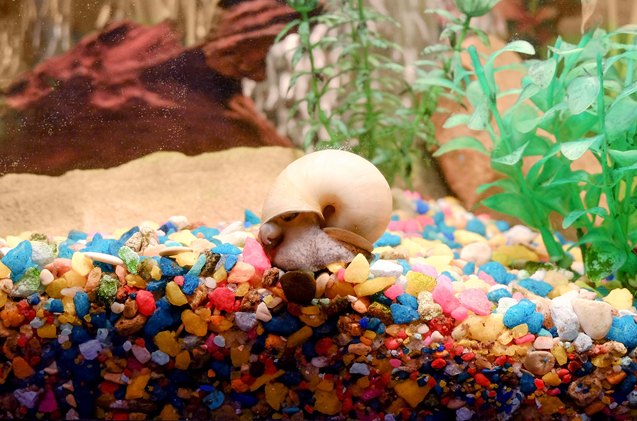Aquarium Snails: The Good, The Bad, And The Ugly

You’d think that snails are something you wouldn’t worry about all that much when you have an aquarium. But that’s where you might be wrong. It’s amazing how quickly snails can spoil your life. What starts out as a small nuisance may end up becoming a “Snail Apocalypse!” that completely turns your aquarium environment upside down. If you are unprepared, the snail problem can really give you a serious headache. Here’s how these visitors get into your Aquarium and what you can do about it.
At first, spotting snails in your aquarium doesn’t seem like a big deal. If anything it’s almost like finding a new free animal in your underwater paradise. They are unique, look interesting, and are fun to observe. However, that novelty wears off rather quickly. Sure, a tiny little snail working its way up the stem of one of your aquarium plants might be cute now, but a few days or weeks from now that one snail could turn into dozens more. And that is when the problems arise. These creatures breed exponentially and can quickly take over your entire aquarium and ruin it. Before you know it, the snails in your tank might outnumber your fish and they can become an unsightly nuisance. Of course, when they are numerous, these snails can change the ecosystem of your aquarium, and potentially hurt the delicate needs of your fish. Admittedly, some aquarium snails can be beneficial, but the ones that enter your tank accidentally generally are not. This can be a major headache for aquarium owners and while it might not seem like a particularly common problem, it’s amazing how often this comes up. So it’s a good idea for any aquarium owner to be prepared for dealing with a pesky snail invasion. Unless you’re ready to deal with a snail invasion as soon as the first one appears, it’s easy to get overwhelmed.
How Do Snails Enter the Aquarium?
Snails are sneaky! There are two ways that snails can enter your aquarium: accidentally and intentionally. Snails enter the tank accidentally in most cases through aquarium plants. If you buy your aquarium plants from a tank at the pet store, there is a significant risk that you could also be buying juvenile snails or snail eggs that will hatch after you place the plant in your tank. Unfortunately, it’s tough to identify these eggs at the store, so the best protection here is just to buy all your aquarium plants from a reputable source (ie no Craigslist listings). Still, it is sometimes difficult to spot these tiny things! A small snail cna stick to the underside of a plant leaf, and you will totally miss it when buying plants. Otherwise, they will lay eggs and those will be even harder to spot. Snail eggs can also be transferred through tank water or by swapping aquarium décor items from one tank to another. To some degree, aquarium snails might be beneficial as they feed on accumulated detritus in your tank. They might become a problem, however, if they start to eat your aquarium plants or clog your filter intake tube. So, it’s always best to stomp out your snails at first sight so that they don’t grow into a much larger problem.
Tips for Removing Nuisance Snails
If you can even see one snail, there might be dozens more hidden somewhere in your tank. They are surprisingly good at camouflage: a number of small snails can be very hard to differentiate from the aquarium gravel. Snails can reproduce very quickly in a home aquarium, so if you have a nuisance snail population, you should act quickly to get it under control. This problem will grow from bad to worse in no time. Your first instinct for snail control might be to buy some kind of chemical solution from the pet store, but that would be a mistake. The chemicals that kill the snails could also harm your fish or impact the water chemistry in your tank. Needless to say, that is a big “no no”. You might also end up killing off your beneficial bacteria. These chemical solutions are far too unpredictable and unsafe for most home aquariums. Your best bet is to add some fish to your tank that feed on snails. However, if adding more fish will disrupt the balance of your tank in any way, your next best option is to remove the snails manually. To do so you can simply pick them out by hand or add a piece of blanched lettuce to your tank before bed each night. Why blanched lettuce? Because snails love it! The snails will flock to the lettuce and feed on it so you can just remove and throw away the piece of lettuce along with all the snails in the morning.
Adding Fish—and Snails!—to Remove Unwanted Aquarium Snails
One way to get rid of unwanted aquarium snails is by introducing fish that will make a meal of those snails. That is always a possibility. There are some aquarium fish that can be considered predatory, and won’t hesitate to swoop in and eat the smaller snails they see. Before you head out to buy these fish, however, there are a few things that you should think about.
First off, you’ll want to do your research into the specific types of fish that prefer eating snails. A clown or yo-yo Loach, gouramis, or betta should do the trick and feast it’s way through those snails rather quickly. However, it’s worth keeping in mind that even if you introduce one of those fish to your tank, the fish may not end up eating your snails. Or they may not eat all of the snails. Fish have a mind of their own, after all, and they might decide that they are content with only eating the food that you give them. Bottom line: there aren’t any absolute guarantees that the fish will eat the snails. It’s certainly an option to fix your snail problem, but not a perfect one.
Secondly, when choosing fish that you will add to your tank, for whatever reason, you should also do your research to ensure that they will get along well with the other fish in your aquarium, as well as any other species you have living in your tank. The last thing that you want to do is stress out the animals living in your aquarium (or put them in harm’s way) by introducing new fish that aren’t compatible or are aggressive. That will be an even worse problem than anything that could be caused by the snails.
When it comes to the types of fish that are well-known for eating snails, loaches are at the top of the list. Several types of loaches are a good choice when you want to get your snail situation under control. For example, the clown loach is a popular choice because it’s known for feasting on snails. Just bear in mind that these fish can grow rather long, as they can reach more than 8” as adults, so you should only introduce them to your tank if you have enough space for them.
On top of that, they do prefer to be in schools, so getting several of them will be necessary as well. Another example is the yoyo loach. These are smaller as adults than clown loaches, and they’re also the type of fish that will eat snails in addition to whatever food you provide. Again, it is best to keep a few of them so that they can school. And other smaller loaches include dojo loaches and skunk loaches, so those might be good options for your aquarium as well.
If you don’t want to add more fish to your tank, or you simply can’t do so for any reason, you do have another option. You can always add new snails to your tank that will eat the other snails. I know it sounds a bit absurd. An all-out snail war! You want to remove snails from your tank, but you’re adding more snails to make that happen. However, it does work. A popular choice is the assassin snail. These striped snails are attractive to look at, as well as functional because they will go about eating other small snails in your tank that you don’t want. Keep in mind that this is a freshwater snail species, and some experts recommend that you maintain your water pH range from 7 to 8, and your water temperature range from 75-80°F. Remember, keeping your water quality high is going to help these snails thrive and get the job of removing other snails done. So be careful with your tank if you plan on using this solution.
We know that this can all sound confusing, but it is generally a simple thing. You spot the snails, deduce whether or not they are a good addition to the tank, and you take it from there. If the classic methods of extraction fail to remove the pest, you can purchase some good snails and see them munch up the bad ones.
Good Snails for the Aquarium
When you see a tiny snail moving across the front of your tank, your first instinct may be to panic but keep in mind that not all snails are bad. Before you take drastic measures to eliminate the snails in your tank, take a moment to determine whether it might actually be a beneficial snail. Sometimes snails can be a good thing! Yup – not all snails are destructive and bad for the aquarium. There are those that can actually benefit your tank, and can be readily purchased in pet stores. Below you will find a list of snails that can be good for the aquarium. So make sure that your new unwelcome snail isn’t one of these beauties before you try to remove it:
- Nerite Snails – This snail varies in size from small to medium and they can be either freshwater or saltwater snails. Nerite snails only grow up to about 1 inch in size and they require brackish water to breed so you don’t have to worry about them taking over your freshwater tank. They will survive, but won’t multiply in freshwater. Nerite snails have the good reputation of being fantastic tank cleaners. They munch up the accumulation of algae and are best in this role. That’s why they are often bought as aquarium cleaners! Nerite snails are described as tranquil and docile, and they can be seen moving throughout the tank with surprising ease.
- Apple Snails – This is the most popular type of beneficial snail for the freshwater aquarium. Apple snails are available in a variety of colors and they can grow as large as 6 inches, though that is fairly uncommon in the home aquarium. Apple snails are very popular as an addition to lively aquariums: they do not pose any risk to fish or shrimp species, and are also very great cleaners, munching up those algae wherever they are. They also tend not to eat plants. If they do take a nibble, add some quality algae wafer and the problem will quickly disappear.
- Trumpet Snails –These snails have conical shells and they are great at feeding on detritus in the home aquarium. In fact, these snails burrow into the substrate to find food. Another interesting point about trumpet snails is that when they reproduce they produce live young instead of eggs. They make another popular tank addition, simply because they are so voracious. They quickly eat up fish food detritus or excess algae, and keep your tank looking clean as always. They are also very hardy, and can thrive in a variety of water types and conditions.
Once aquarium snails take hold of your tank they do not let go easily – they reproduce quickly and can easily become a problem if you aren’t careful. Take the time to determine whether or not the snails in your tank are beneficial and, if they are not, act quickly to get them under control. These creatures can be a helpful part of your home aquarium or a nuisance that takes over the entire tank. It all depends on the breed. So the key thing here is acting quickly. Identify which snail you have and then make a call about how to get rid of them. There are several options and it isn’t too difficult to achieve as long as you act quickly. So don’t delay once your spot a snail in your aquarium. This problem is easy to solve if you act fast, but almost impossible to deal with once you have a full fledged infestation of unwanted snails. Good luck!
Of course, if you are a newcomer to the world of aquariums and still spot snails, don’t hesitate to ask for help from a senior aquarium keeper. There are many clubs and forums where aquarium enthusiasts can share their tips, tricks, and experiences. Finding some great advice here can be a life changing thing to do.
Do you have any other solutions for dealing with pesky snail invasions that we didn’t think of? If so, please let us know in the comments below.
We are committed to finding, researching, and recommending the best products. We earn commissions from purchases you make using the retail links in our product reviews. Learn more about how this works.

Kate Barrington is the loving owner of two cats (Bagel and Munchkin) and a noisy herd of guinea pigs. Having grown up with golden retrievers, Kate has a great deal of experience with dogs but labels herself a lover of all pets. Having received a Bachelor's degree in English, Kate has combined her love for pets and her passion for writing to create her own freelance writing business, specializing in the pet niche.
More by Kate Barrington























